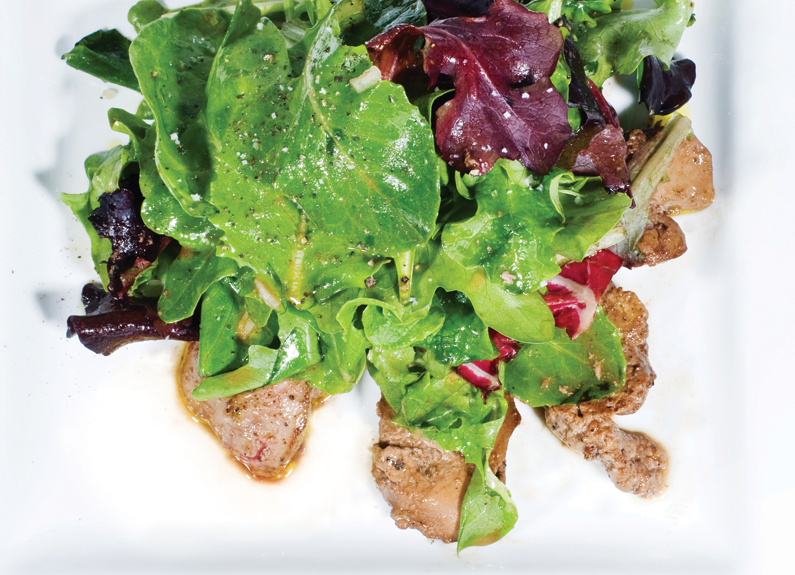
Recalling Forgotten Flavors
A lesser cut can still be a cut above
"Waste not, want not” still resonates with modern chefs – who are adding the long-forgotten flavor of lesser-known cuts to haute cuisine.
Wes Johnson, chef de cuisine at Eclipse, takes this adage to heart by innovating with more obscure cuts on the hotel’s new late-night menu. From 10 p.m. to 2 a.m., diners can feast on dishes featuring beef cheek and bone marrow, among other offbeat treats. More specifically, Johnson offers an oxtail soup incorporating short ribs as well as chicken livers and gizzards. For hard-core liver fans, his late-night menu also includes a seared chicken-liver salad.
Johnson said some of these offerings will eventually make it to the main dining menu as well. (Notably, as an appetizer, that menu already includes beef marrow roasted in red wine, which Johnson described as tasting like “beef-flavored butter.”) As a hotel, Eclipse still has to have a menu featuring plenty of luxury cuts, he said, but being a hotel also means the kitchen runs 24/7, which allows lots of experimentation and opportunities to find creative uses for all the unexpected bits.

Anthony Devoti, chef and owner of Five Bistro and Newstead Tower Public House, also favors nontraditional morsels. He buys whole lambs and hogs and uses almost everything from the head to the tail. “Budget-wise, it’s great to do,” Devoti said, and creatively, it allows chefs latitude they might otherwise lack. “There’s so much there to play with.”
After all, less than a fifth of a typical beef or hog carcass is loin, the section that yields high-end cuts like sirloin and tenderloin. That leaves a lot more meaty goodness to be had, like the oft-overlooked pig head, which Devoti identified as a favorite of his. Kevin Nashan, chef and owner of Sidney Street Cafe, agreed and named teste proscetta, which he likened to a cross between prosciutto and lardo, as one of his favorite uses for the porcine noggin. Nashan is also a fan of offal in general, with confit of sweetbreads a menu fixture at Sidney Street.
Though many cultures don’t consider these taste sensations out of the ordinary, the average diner in the States has forgotten the pleasures of the more esoteric areas of an animal. “It’s amazing [that] people got away from using these cuts,” Johnson said, “because there’s so much more flavor to be had with them.”
But as delicious as such off-the-grid goodies may be, some patrons need convincing. Chefs up the appeal of these novel tidbits by pairing them with more familiar fare. Nashan does this by coupling items like bone-marrow gratin with rib-eye steak, or lamb neck and rib pockets with classic lamb chops. Benjamin McNabb, chef de cuisine at Seasons St. Louis, said he’s incorporated uncommon offerings in conventional dishes in order to make his customers more comfortable with trying something new, like using oxtail or game animals like rabbit in soups and raviolis. “There are so many things you can do,” said Nashan. “It’s just a matter of getting people to try it.”

Of course, some customers won’t ever nosh on offal or dig into a pig head. Fortunately, plenty of more familiar lesser cuts exist. Andy Shrensker, chef at Mihalis Chop House, said he’s tried including beef tongue and oxtail on his menu, with little success. As a chophouse, the restaurant customarily draws diners for a steak or ribs, he said, pure and simple. But they might try a more traditional lesser cut that’s prepared well. In that light, he’s recently succeeded with bone-in specials, especially braised short ribs, as an alternative to the top cuts at Mihalis.
McNabb said diners should remember that a “lesser” cut may remain prime meat and can be turned into something special. “They’re still fantastic cuts,” he remarked. “They’re just not the prime strip steaks that are going to cost you $40 when you go out to eat.”
McNabb (who, like Devoti, frequently buys whole animals and uses nearly everything the carcass yields) likes the more pedestrian portions, such as leg of lamb and short ribs. “Short ribs are one of the toughest cuts,” McNabb said, “but also one of the most flavorful.” Coaxing the goodness from them takes more effort; McNabb (like Shrensker at Mihalis) braises short ribs, for three hours or so, but considers the result worth the effort. “The people who do venture off and try those cheaper cuts of meat, especially when it’s braised, like a short rib, and it’s tender as can be, they’re like, ‘Oh, my gosh,’” said McNabb. “They never expected it to be that good.”
So at the end of the day, it’s up to the customer to take the plunge. As McNabb said, “There’s a personal level of commitment required, to trust the chef that it’ll be good.”
Commit, and there’s plenty of once-forgotten flavor awaiting you.
Tags : Restaurants
Most Recent
Hi-Pointe Drive-In, Taco Buddha create Gastronauts Food Group with national expansion plans in the works
The teams behind beloved St. Louis restaurants Hi-Pointe Drive-In and Taco Buddha …





